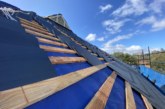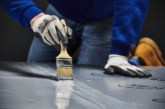Adrian Pargeter, Head of Technical and Product Development at Kingspan Insulation Limited, assesses how the overall cost associated with building a house can be reduced by specifying premium performance cavity wall insulation.
Managing upfront costs is a major concern for all developers. When it comes to determining specifications, however, it is important to not only consider the cost of each material but also how their properties can affect the overall design and cost of each unit. New research from Currie & Brown has now shown that by specifying premium performance cavity wall insulation, over cheaper, thicker materials, developers can save on upfront costs whilst reducing wall construction depths.
Cavity considerations
Masonry cavity wall approaches are the preferred method of housebuilding for developers across large parts of the UK. Whilst many of the basic techniques haven’t changed greatly in the past century, the tightening of the Building Regulations and Standards relating to energy efficiency mean that walls must now be insulated to a high standard. For new homes, these requirements are covered within Approved Documents L1A to the Building Regulations 2013 (in England), 2014 (in Wales), and Section 6 (Energy) 2015 of the Building Standards in Scotland.
To ensure compliance, it is a good idea to target an external U-value of 0.16 W/m²·K for properties in England and Wales and 0.15 W/m²·K in Scotland. A wide variety of cavity insulation products are now available to achieve this. When specifying these items, it is important to consider what the thermal conductivity (lambda value) of the material is. This is the measure of how a material conducts heat. Materials with a low thermal conductivity value are more resistant to heat loss through conduction, meaning a reduced thickness of insulation can be used to achieve the same level of thermal performance.
Cheaper materials often have relatively high thermal conductivities. For example, the typical thermal conductivity of mineral fibre cavity wall insulation is between 0.032-0.037 W/m·K. In contrast, the latest phenolic insulation boards have a thermal conductivity of just 0.018 W/m·K. As such, whilst the insulation boards themselves are more expensive than lower performing materials, they can enable the desired U-value to be reached using thinner insulation and thus creating a thinner overall external wall construction. This can have significant effects for other areas of the construction such as the size and cost of foundations.
To understand how this may impact overall project costs, Kingspan Insulation commissioned leading construction consultancy Currie & Brown to carry out an analysis.
Research
To assess how the choice of insulation could impact overall project costs, Currie & Brown developed scenarios for properties of three different scales:
• large detached;
• small detached; and
• mid-terraced.
Each property was modelled using SAP 2012 and was designed to meet the requirements of Approved Document L1A to the Building Regulations 2013 (England). Two external wall constructions with a U-value of 0.16 W/m2.K were modelled for each scenario, one with mineral fibre insulation and the other with premium performance phenolic insulation. The full specifications are shown in Table 1.
| Specification | Thickness (mm) |
| Brick outer leaf (102.5 mm)
• 100 mm cavity including 90 mm phenolic insulation • 100 mm blockwork inner leaf |
302.5 |
| Brick outer leaf (102.5 mm)
• 180 mm cavity fully filled with mineral wool insulation • 100 mm blockwork inner leaf |
382.5 |
The cost analysis was then conducted by an experienced residential quantity surveyor. In addition to the upfront cost of the insulation, the analysis considered a wide range of variables linked to the cavity width and overall thickness of the external walls including the length of wall ties, rafters and joists, width of cavity closers and the extent of foundations.
In all scenarios, foundations are 300 mm deep in a 600 mm trench. It was assumed that the thinner cavity for the phenolic insulation specification would allow a narrower foundation of 650 mm compared with 900 mm for the mineral fibre specification.
Results
The analysis showed that whilst the cost of the mineral fibre insulation itself was less than the phenolic insulation, the increased cavity width with the mineral fibre specification raised the cost of all accessories such as lintels, wall ties and cavity closers. Furthermore, the need for more extensive foundations and associated groundworks, along with the additional roof and wall areas, also added significantly to the overall cost of the mineral fibre construction.
When all these factors were considered, the analysis showed that the overall cost for the large and small detached houses with the phenolic insulation specification and 600 mm foundation was actually less than that of the mineral fibre specification with a 900 mm foundation (as shown in table 2). Meanwhile, for the mid-terraced property, the cost differential was negligible.
| House Type | 100 mm cavity phenolic insulation specification with 600 mm foundation | 180 mm mineral fibre specification with 900 mm foundation |
| Large detached | £53,993 | £54,154 (+£161) |
| Small detached | £41,324 | £41,744 (+£420) |
| Mid-terraced | £9,801 | £9,797 (-£4) |
In addition to these cost benefits, the reduced construction thickness of the phenolic insulation specification should also allow window reveal depths to be minimised. Research has shown this can allow more light into internal spaces and may make them more attractive and saleable to potential buyers.
The wider picture
With so many costs to manage on a project, it’s understandable that some specifiers have chosen to select materials based on their individual price, particularly when the materials themselves are not visible to buyers. As the Currie & Brown research shows, however, by thinking more holistically about how products may impact other areas of a design, it may be possible to select thinner, higher performing insulation whilst saving money.










